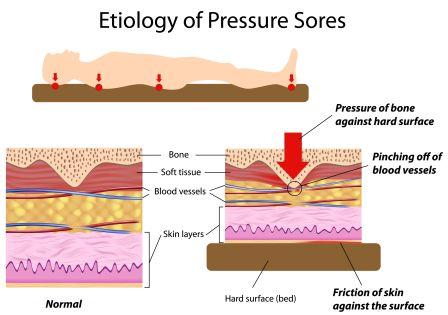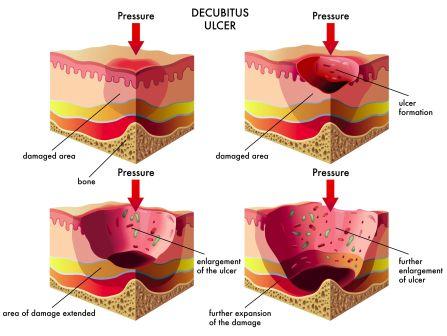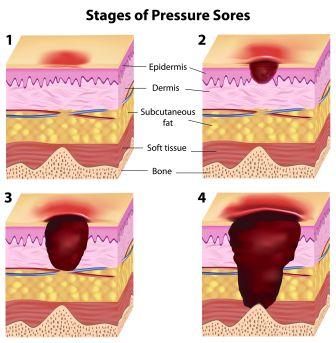Bed Sores – Ayurvedic Medicines, Home Remedies
Bedsores — also called pressure sores or pressure ulcers — are injuries to skin and underlying tissue resulting from prolonged pressure on the skin. People with limited ability to change their positions at bed, who are on wheelchair, are more prone to this skin condition.
In Ayurveda, it is named as Shayya vrana. Shayya means lying down or sleeping. Vrana refers to ulcers or wounds. In medical terms, they are called decubitus sore or decubitus ulcer.
Table of Contents
Risk factors
People who are at risk of developing bed sores:
People with less or no mobility due to poor health or weakness, paralysis, injury, on wheelchair, on sedation and coma are commonly affected with bed sores.

Other factors that increase the risk of pressure sores include:
Age: The skin of older adults is generally more fragile, thinner, less elastic and drier than the skin of younger adults. Also, older adults usually produce new skin cells more slowly. These factors make skin vulnerable to damage.
Lack of sensory perception: Spinal cord injuries, neurological disorders etc can result in a loss of sensation. An inability to feel pain or discomfort can result in not being aware of bedsores or the need to change position.
Weight loss: Weight loss is common during prolonged illnesses, and muscle atrophy and wasting are common in people with paralysis. The loss of fat and muscle results in less cushioning between bones and a bed or a wheelchair.
Poor nutrition and hydration: People need enough fluids, calories, protein, vitamins and minerals in their daily diet to maintain healthy skin and prevent the breakdown of tissues.
Excess moisture or dryness: Skin that is moist from sweat or lack of bladder control is more likely to be injured and increases the friction between the skin and clothing or bedding. Very dry skin increases friction as well.
Bowel incontinence: Bacteria from fecal matter can cause serious local infections and lead to life-threatening infections affecting the whole body.
Diseases affecting blood flow such as diabetes and vascular disease, increase the risk of tissue damage.
Smoking reduces blood flow and limits the amount of oxygen in the blood. Smokers tend to develop more-severe wounds, and their wounds heal more slowly.
Limited alertness: People whose mental awareness is lessened by disease, trauma or medications may be unable to take the actions needed to prevent or care for pressure sores.
Bed sore causes
How bed sores are caused?
Sustained pressure in areas that aren’t well-padded with muscle or fat and that lie over a bone, such as spine, tailbone, shoulder blades, hips, heels and elbows are the common areas affected.
Friction: Friction may occur when the skin is dragged across a surface, such as when the patient change position or a care provider moves the body of the patient. The friction may be even greater if the skin is moist. Friction may make fragile skin more vulnerable to injury.
Shear: Shear occurs when two surfaces move in the opposite direction.
Characteristic features
Features of Bed sores:
Wounds (ulcers) with itching and burning initially (later without sensation) in the locations like back,
Thigh, buttock, calf etc are commonly found. Occasionally ankle and heel are also affected.
Pus or serous discharge are also found.

Common sites
Common sites of bed sores:
For people who use a wheelchair, bed sores often occur on skin over the following sites:
Tailbone or buttocks
Shoulder blades and spine
Backs of arms and legs where they rest against the chair.
For people who are confined to a bed, common sites include the following:
Back or sides of the head
Rim of the ears
Shoulders or shoulder blades
Hip, lower back or tailbone
Heels, ankles and skin behind the knees.

Line of treatment
Line of Treatment of Bed sores (Shayya vrana):
Hygiene:
Cloth, bed spread etc are to be cleaned daily.
Urine and stool are evacuated properly and much precaution is taken each time.
Water beds / air beds are used for effective management.
External application
External application Ayurvedic medicines for pressure sores:
The wound should be washed properly. Measures of disinfection are undertaken.
Now-a-days good number of antibiotic powders, lotions and ointments are available and can be used on due consultation.
Dusting of fine powder of purified borax (Tankana bhasma) is very effective against bed sores. Even though initially it causes burning sensation, it reduces the discharge and dries up the wounds.
If there is oozing from the sores, then triphala powder can be applied locally.
Triphala kwath – water decoction can be easily prepared at home to wash the wounds, before dressing. Learn how to prepare Triphala kwath from Triphala powder.
Potent Ayurvedic oils:
Ropana taila, Jatyadi oil, Jatyadi ghrita and Vranabhairava taila are useful against the bed sores.
To reduce the pain, swelling as well as ulceration: Application of Panchaguna taila
In noninfective wounds: Kanaka taila is very effective.
Ointments Useful in non healing ulcers: Sindoora malahara and Gandhakadya malahara
Ayurvedic medicines
Ayurvedic medicines for bed sores:
As you can see, most of the below products have bitter herbs like neem, giloy, Vasaka etc as main ingredients.
Gandhaka rasayana – used in the treatment of skin diseases, itching, chronic fever, urinary tract disorders etc.
Triphala guggulu – widely used in the Ayurvedic treatment for weight loss.
Kaishora guggulu – It acts as – ageing skin health promoter, joint health, natural blood cleanser, useful as supportive dietary herbal supplement in many health conditions such as diabetes, skin diseases etc.
Arogyavardhini – used in the treatment of liver diseases, fever, skin diseases, etc
Mahamanjishthadi kashaya – a famous blood detoxifier, mainly used in treatment of skin diseases.
Mahatiktaka kashaya – used to treat wide range of skin diseases, abscess, non healing wounds and sinuses. It is an herbal decoction preparation, also available in Kashayam tablet form.
Pancha tiktaka kashaya – is a liquid Ayurvedic medicine for abscess, fever, boils, arthritis, pustules etc.
Guggulutiktaka kashaya – used in treating inflammatory conditions of skin, joints and bones. Useful in deep seated decubitus sores.
Rasamanikya – used in the treatment of bronchitis,fever and asthama
Malla sindura – used in Ayurvedic treatment of Asthma and syphilis. This medicine should only be taken strictly under medical supervision.
Guggulupanchapala choorna – mainly used in skin diseases and rectal fistula.
Nimbamrita kashaya, Nimbadi guggulu etc
Kashayas recommended for washing the wounds:
Panchatiktaka kashaya
Panchavalkala kashaya
Manjishthadi kashaya,
Nimbapatra kashaya – neem decoction
Triphala kashaya
Medicinal formulations for Vrana From Sahasra Yoga Text Book
Dinesavallyadi Taila
Durvadi Taila
Vranaropana Taila
Vranabhairava Taila
Kaisora Guggulu
Amruta Guggulu
Yogaraja Guggulu
Vrana Lepa
Niruryadi Gutika
Veppin Toladi Kashaya
Pullanyadi Tailam
Gopyadi Ghritam
Unwholesome diet and habits
Masha (Black gram) and its derived products
Tailabhrishtha ahara(Fried food)
Brinjal
Curd
Night awakening
Smoking
Neglecting high blood sugar levels and diabetes
Wholesome diet and habits
Mudga – green gram
Rakta shali – Red rice/Boiled rice
Ushnodaka – Warm water
Jambeera – Citrus fruit
Madhu – Honey
Ghrita- Ghee
Ksheera – Milk
Kashaya-tikta-katu rasa – Astringent, bitter and pungent food
Bed sore is the health complaint which makes the patient and the family dreadful.Early detection, good hygiene and local and oral medicines can help in quick healing.










One comment
Kristy
A tip for people who use a wheelchair to relieve or prevent sustained pressure: try a special feature wheelchair. One that has the option to tilt in space, or, even better, a stand-up wheelchair.